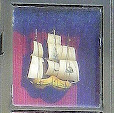

View more Monday Mosaics at Mary’s Little Red House
The fountain in the square in front of our Town Hall is from 1941 by artist Nils Sjögren.
The reliefs surrounding the fountain show working life through the history of the town.

I see now that besides the fountain, I caught something in the picture above which I was not aware of at the time. Do you see it? Don’t worry. It’s not a man about to jump off the roof. It’s just another statue… I’ll get back to that one another day!

Photo taken from the stairs of the Town Hall looking across the square.
This day was also Military Music Day, and all the people are waiting around for a parade.
More pictures of that coming up some other day.
Surround by Richard Nonas
This photo was taken on a Sunday afternoon after all the shops in the city had closed. Normally on a sunny summer day there will often be people using these stone chairs as seats. Unlike some of our other recent sculptures, these ones were made for it…!
Standing in the square in front of our Town Hall, still used as court house, this circle of stone chairs reminds of ancient meeting places for assemblies - ‘t(h)ings’ - discussing matters of importance, and keeping up law and order. Ancient circles of standing stones were traditionally believed to be used for gatherings such as these. Those were/are called “rings of judges”.
A 'thing' or 'ting' (Old Norse, Old English and Icelandic: þing; other modern Scandinavian languages: ting) was the governing assembly in Germanic and some Celtic societies, made up of the free people of the community and presided by lawspeakers, meeting in a place called a thingstead. One task for the ‘ting’ was to hear witnesses to rule whether the accused was guilty or not. Today the term still lives on in the official names of national legislatures and political and judicial institutions in the Nordic countries. (Wikipedia)
(I will be showing close-up photos of the fountain some other day.)
(14:12) Just watchin’ the clouds on a late May afternoon…
(16:11) Oh oh, maybe time to go inside soon…
---
To watch more of the sky from all over the world, visit Skywatch Friday
Anna Lindh was a Swedish Social Democratic politician who served as Swedish Minister for Foreign Affairs from 1998 until she was murdered in 2003. She died on the early morning of September 11, following a knife attack in Stockholm on the afternoon of September 10.
A small park in our town (across the river from the main park) has recently been renamed in her honour, in connection with acquiring the sculpture Non-Violence by Carl Fredrik Reuterswärd.
A similar sculpture (a revolver tied in a knot) by the same artist is placed outside the United Nations Headquarters in New York City.

Forget-me-not - Myosotis scorpioides – Förgätmigej
I found these growing beside the river. I love it when I find wild flowers growing “in town”!
The Forget-Me-Not has the same name in several languages (Swedish included).
There are a number of legends about the origin of the name:
In a German legend, God named all the plants when a tiny unnamed one cried out, "Forget-me-not, O Lord!" God replied, "That shall be your name." In a similar legend, the little flower cried out, "Forget-me-not!" as Adam and Eve left the Garden of Eden.
Another legend says that the Christ Child was sitting on Mary's lap one day and said that he wished that future generations could see her eyes. He touched her eyes and then waved his hand over the ground and blue forget-me-nots appeared.
One legend has it that in medieval times, a knight and his lady were walking along the side of a river. He picked a posy of flowers, but because of the weight of his armour he fell into the river. As he was drowning he threw the posy to his loved one and shouted "Forget-me-not".
This is a flower connected with romance and tragic fate. It was often worn by ladies as a sign of faithfulness and enduring love. In 15th-century Germany, it was supposed that the wearers of this flower would not be forgotten by their lovers.
The Colours of the Rainbow:
RED – ORANGE – YELLOW – GREEN - BLUE – INDIGO - VIOLET
From a physics point of view, the rainbow spans a continuous spectrum of colours—there are no "bands." Newton originally (1672) named only five primary colours: red, yellow, green, blue and violet. Only later did he introduce orange and indigo, giving seven colours - by analogy to the number of notes in a musical scale! (I have to say, I always had difficulties identifying “indigo”.)
I also have a Rainbow post at my other blog today – The Island of the Voices. There you can read a bit about mythology and folklore connected with rainbows; and also about the phenomenon of the double rainbow.
Just as I thought I had the daffodil/narcissus definitions more or less sorted out, I ran into this one! It is the exact same shape as the yellow ones I think of as daffodils (Swedish påsklilja=Easter lily). See the middle picture in the collage in the previous Narcissi post. But - this one is all white!!! (In my mind a White Daffodil rather than a typical Narcissus!) I give up… (LOL)
Not quite sure about what kind of tree, but probably Whitebeam - Sorbus – Vitoxel
It is a huge tree, and this photo was taken from below looking up and zooming.
In a Narcissus post last week I mentioned that in Sweden we use different names for the yellow ones (middle picture in this collage) and the white ones. (‘Easter Lily’ vs ‘Pentecost Lily’)
Hmm… Since then, just on my recent walks in the neighbourhood of where I live, I’ve realized that the distinction is not always as easy to make as it may seem at first glance…



“The splendor of the rose and the whiteness of the lily do not rob the little violet of it’s scent nor the daisy of its simple charm. If every tiny flower wanted to be a rose, spring would lose its loveliness.” ~ Therese of Lisieux ~
Daisies and Dandelions
The Swedish name for the daisy - Tusensköna – means “thousandfold beauty”.
From my childhood, I remember these especially from one place I used to visit with my grandparents. They had these three old friends, two sisters and a brother, who lived together in a little red wooden cottage far out in the countryside. These little white flowers covered the whole lawn in front of that house, and therefore the name always seemed very appropriate to me.
The Swedish name means “pearl hyacinth”.
The Latin name Muscari has to do with the scent said to be resembling musk.
Some species are among the earliest to bloom in the spring. They are planted as bulbs and tend to multiply quickly in well drained sandy soil. May be found in woodlands or meadows, and commonly cultivated in lawns, borders, rock gardens etc.
I’ve sometimes had these on my balcony in the early spring, together with daffodils.
The second photo from my (previous) balcony in 2007.
Yellow and blue are the colours of our Swedish flag.
Blue and yellow have been used as Swedish colours for more than 700 years. According to legend, the Swedish king ‘Eric the Holy’ saw a golden cross in the sky as he landed in Finland during the First Swedish Crusade in the 1150s. Seeing this as a sign from God, King Eric adopted the golden cross against a blue background as his banner. (Historians however debate whether even the crusade ever took place.)
Now this may sound like something every Swedish person would know. As a matter of fact though, I’m not sure I ever heard that legend until I read it just now in the Wikipedia article!
The English Wikipedia article puts these two together under the name Daffodil or Narcissus (plural Narcissuses or Narcissi in BE, Narcissus in AE).
There are two derivations of the name Narcissus. One is that of a young man in Greek mythology who became so obsessed with his own reflection in a pool that he fell into the water and drowned. The Narcissus plant first sprang from where he died.
The other derivation is that the plant is named after its narcotic properties (ναρκάω narkao, "to grow numb" in Greek). All Narcissus varieties contain the alkaloid poison lycorine. The name Daffodil is derived from an earlier "Affodell", a variant of Asphodel. In Greek legend the asphodel is one of the most famous plants connected with the dead and the underworld.
In Swedish we have different names for these two Narcissi: We call the yellow one “påsklilja”, which means Easter Lily, and the white one “pingstlilja”, which means Pentecost Lily. (This will tell you that the yellow ones usually appear a bit earlier than the white ones, in our climate.) Because the yellow one is associated with Easter and early spring, it is also often used as a symbol of Life and Resurrection rather than Death. We do also use the name “narciss”, but most people associate that with the white one rather than with the yellow one.
Looking up them up in lists of Flower Language – in Swedish – I find these symbolic uses:
Yellow Narcissus (Påsklilja): “I can’t bear the thought of losing you.”
White Narcissus (Pingstlilja): “I love – but not you!”


Dandelion – Taraxacum – Maskros
The English name dandelion is a corruption of the French dent de lion meaning "lion's tooth", referring to the coarsely toothed leaves.
The Swedish name maskros means "worm rose", which is said to have to do with the small insects usually present in the flowers.
I’m rather surprised that this flower doesn’t seem come with a whole range of alternative popular names, as many of the other wild spring flowers do.
Dandelions are thought to have evolved about thirty million years ago in Eurasia; they have been used by humans for food and as a herb for much of recorded history. They were introduced to North America by early European immigrants.
It is considered a weed and here people usually don’t want it in their lawns. But it is actually a beneficial weed, with a wide range of uses. It has been described as "a plant for which we once knew the use but we've forgotten it". Did you know, for example, that…
(Most of the facts from the Wikipedia article.)
Coltsfoot – Tussilago farfara – Hästhov / Tussilago
The Swedish name Hästhov means Horse’s Hoof.
The flowers (which superficially resemble dandelions) appear early in the spring, on stems with no apparent leaves. The leaves, which resemble a colt's foot in cross section, do not appear until after the seeds are set.
The Latin name "tussilago" means cough suppressant. The plant has been used historically to treat lung ailments such as asthma as well as various coughs by way of smoking. Crushed flowers supposedly cured skin conditions, and the plant has also been consumed as a food product. Caution, though - there are documented cases of it causing severe liver problems in infants.
Alternative English names include Tash Plant (I’m curious about the origin of that!), Ass's foot, Bull's foot, Butterbur, Coughwort, Foal's foot, Foalswort, Horse Foot and Winter heliotrope. (Source: Wikipedia)

I heard Your voice
Whisper to the wild water
Step by Step
Slowly I turnFrom the song ‘Whisper to the Wild Water’ by Máire (Moya) Brennan

Yaweh make me Your stream
Place me inside Your dream
Touch my mouth, softly call
Take me out to the waterFrom the song ‘To the Water’ by Máire (Moya) Brennan
(Both songs from the album ‘Whisper to the wild Water’)

 |


